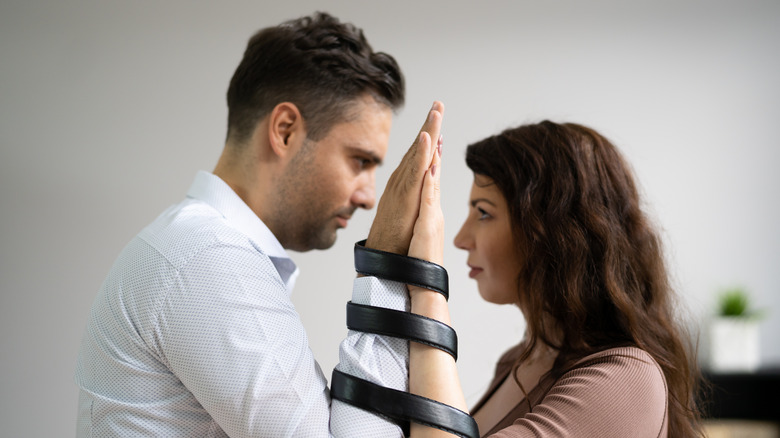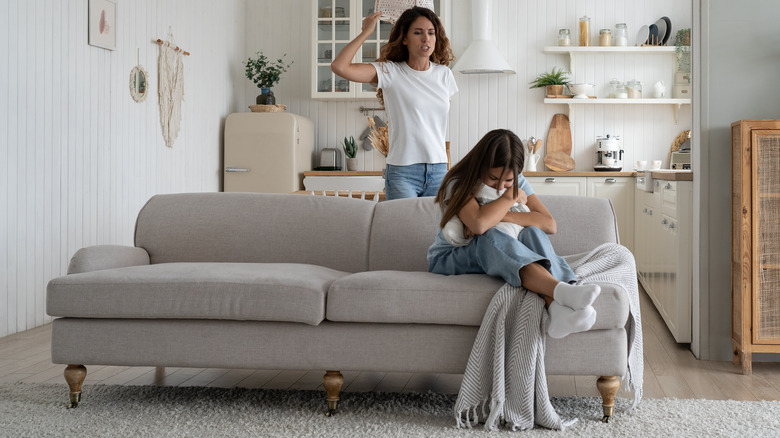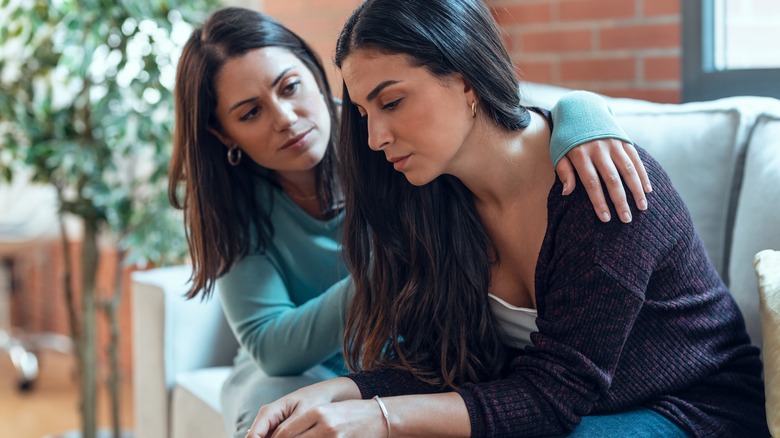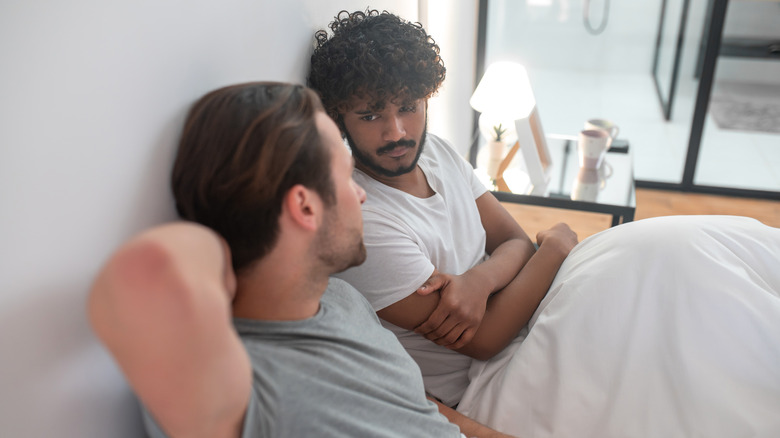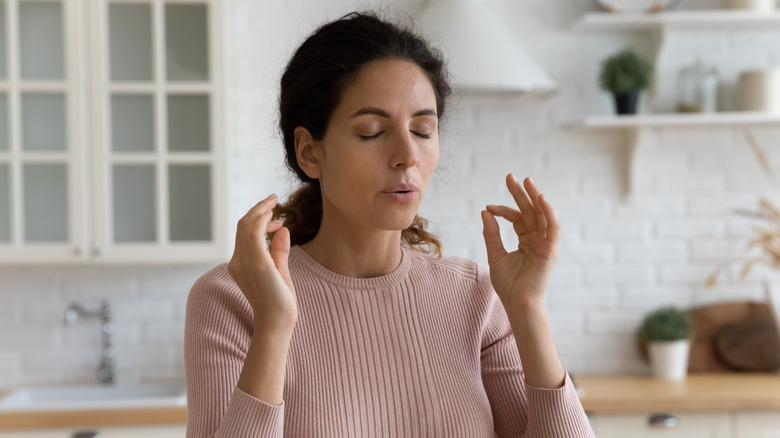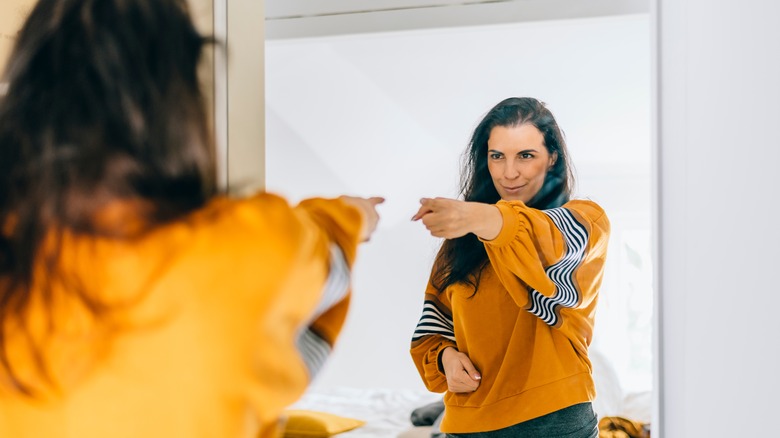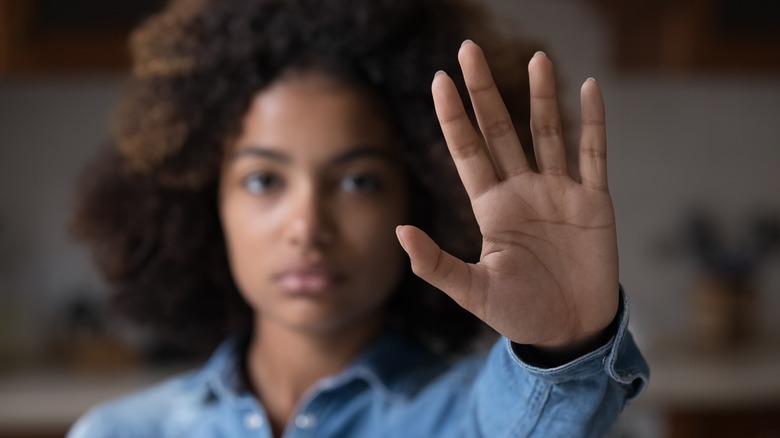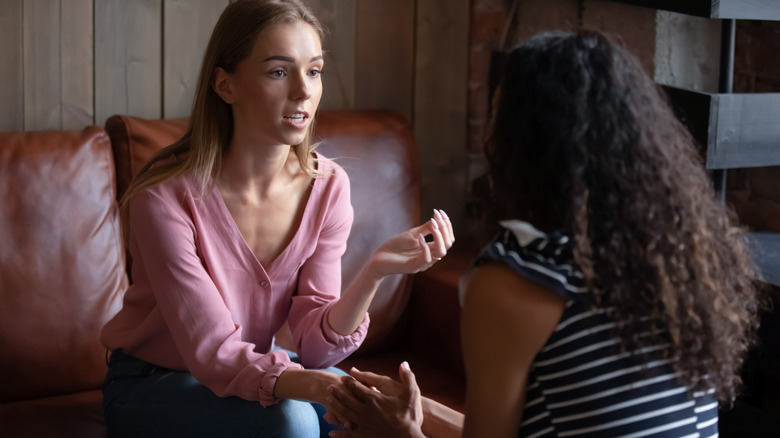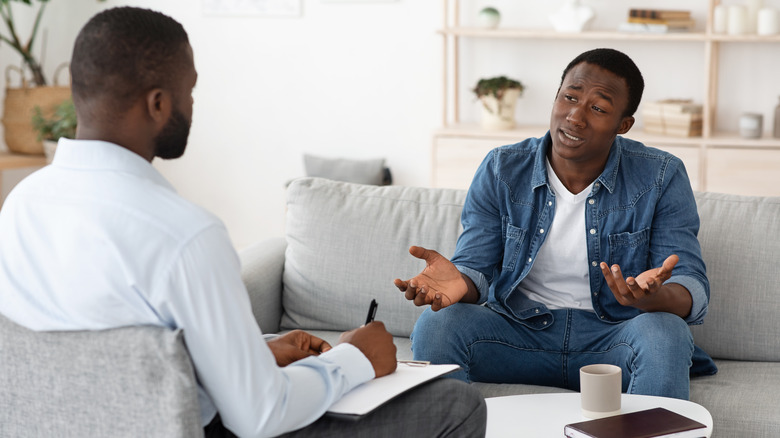How To Curb Codependency In A Relationship
Codependent is one of those words that gets thrown around a lot. Though it's often used to describe people who are clingy in romantic relationships or friendships, codependency is a lot more than just excessive neediness.
Psychology Today describes codependency as "a dysfunctional relationship dynamic" where one person in the relationship plays the role of caregiver and the other person plays the role of the dependent. The caregiver is devoted to meeting the other person's needs, often downplaying or completely ignoring their own needs. The person in the dependent role is reliant on the person in the caregiver role and often consumes the majority of their attention. Sometimes, codependent people will switch between the caregiver and dependent roles based on the relationship or situation.
Codependency is exceedingly common and can show up in romantic relationships, friendships, and relationships with family members. Many of us have been in at least one codependent relationship. The keys to curbing codependency in our relationships are understanding where this dynamic comes from, and learning what behaviors are codependent and how we can break out of the roles we continually take on in our relationships.
Codependency in families
Kristie Overstreet, a therapist who specializes in relationships and intimacy, told Insider that most adults who frequently end up in codependent relationships had a parent who took on either the caregiver or dependent role with their partner and/or their children.
Parents who take on the caregiver role put everyone else's needs before their own and limit the amount of autonomy those around them have so they continue to be dependent on the caregiver. Caregiver parents can be authoritative and exert extreme control over their children with rules and discipline so they learn to be compliant or permissive. These types of parents may also dote on their children, overprotecting them from the real world and preventing them from learning how to problem-solve on their own.
On the other end of the spectrum are parents who take on the dependent role. Everyone in the household, even the children, becomes responsible for caring for this parent. This dynamic often happens when one parent is struggling with addiction or mental health issues. Children with this kind of parent are forced to become caregivers, flipping the appropriate relationship dynamic between parent and child.
When children play the role of dependent or caregiver during their formative years, they grow up believing that these dynamics are normal. They then continue to play these roles in their friendships and romantic relationships until they learn how to break the cycle of codependency.
Codependency in romantic relationships
Often, people who learn codependency as children or young adults often replicate codependent behaviors in their adult friendships and romantic relationships. Coda Derrig, a clinical psychologist for the Cleveland Clinic, explains that codependency is hard to see in the early stages of a romantic relationship because it's normal to get caught up in that new relationship rush.
But as the relationship progresses, the caretaker partner constantly puts their wants and needs on the back burner to cater to their partner. They start to feel selfish for doing anything by themselves or even with friends, feeling like they always need to be available for their partner. The dependent partner starts to demand more time and energy from their partner. They become insecure when their partner wants to do things without them and get upset if they don't touch base with their partner regularly. The dependent partner may start to have episodes of depression or rage if they feel their wants and needs aren't being met.
Often, both partners want the other person to change. Sometimes, one or both partners worry about their partner's emotional reactions and go out of their way to avoid confrontation. Each partner's emotions are deeply impacted and influenced by their partner's feelings, and it can become difficult for them to separate their emotions from their partner's. These dynamics are incredibly unhealthy, but the partners become so entwined it's hard to see the relationship as it is.
Codependency in friendships
We often think of codependency as existing primarily in familial or romantic relationships, but it's actually just as common in friendships. Counselor Meaghan Rice explained in Talkspace that the same roles of caregiver and dependent exist in codependent friendships, but the behaviors are different because of the nature of the relationship.
The hallmark of a codependent friendship is excessive reliance on each other. Instead of cultivating a wide support network, codependent friends rely on each other to meet all, or the vast majority, of their emotional needs. The dependent friend often needs a lot of attention or has a lot of personal problems that they don't know how to handle. The caretaker friend is always on call when there's a crisis, providing all the emotional support, advice, and solutions that the dependent person needs. The caretaker friend is always trying to fix things for the dependent friend, but the dependent friend doesn't mind because that's exactly what they want to happen.
Codependent friends can become so attached that their lives become intertwined. They're together all the time, they go to each other — and often only each other — with all their problems, they abandon other friends, avoid making new friends, and their friendship becomes more important than any other relationship in their lives. These codependent relationships are exhausting and unhealthy for both people, though they usually can't see this because they're so embedded in each other's lives.
Curbing codependency
Codependent friendships and romantic relationships can feel good for both people when the relationship first starts. In an article for PsychCentral, licensed clinical social worker Sharon Martin explains that the person in the dependent role is happy to have someone who's so willing to take care of them, and the person in the caretaker role is happy to provide support because it makes them feel needed. However, as the friendship or romantic relationship progresses, codependency creates a power imbalance that makes the relationship toxic.
Since the vast majority of people who get into codependent relationships learned these dynamics in childhood, they often don't realize that their relationships are unhealthy. For many, codependency is also a coping mechanism that helps them manage anxiety and other difficult feelings. Giving up that coping mechanism can feel scary and overwhelming, making it difficult to curb codependent behaviors. Difficult, but certainly not impossible.
If you think you may be struggling with codependent relationships, here are some things you can try to curb your codependency.
Identify codependent patterns in your relationships
The first step to solving any problem is identifying that the problem exists. Co-Dependents Anonymous, CoDA for short, is a 12-step style support group for people struggling with codependency. The organization breaks codependent patterns into five categories: denial, low self-esteem, compliance, control, and avoidance.
Denial patterns can look like hiding your feelings, blaming others for problems in your relationships, and an inability or unwillingness to see how your relationships are unhealthy.
Patterns like the severe judgment of yourself, a need for validation, feeling less than or better than others, and thinking that you're unworthy all fall into the low self-esteem category.
Examples of compliance patterns include compromising your own values to make others happy, not speaking up when you disagree, changing your behavior to avoid emotional reactions, and remaining loyal to your friend, family member, or partner even when they're being harmful.
Control patterns look like believing that others are incapable of taking care of themselves, demanding that others meet your needs instead of meeting them yourself, and using emotional manipulation.
Finally, avoidance patterns can show up as ignoring your feelings and truth to avoid confrontation, avoiding intimacy, and pushing people away when they get too close.
Reflect on all the major relationships in your life and write down, how these patterns have manifested in each of your relationships. This will help you know what you need to work on to curb your codependency.
Identify why you engage in codependent behaviors
As we've already mentioned, codependency is almost always learned during childhood. Licensed Counselor Meaghan Rice elaborates on this in an article for Talkspace. She states that codependency is most often created when parents are overprotective, too permissive, emotionally or physically abusive, neglectful, or addicted to substances. To understand where your codependent behaviors come from, take an honest look at your childhood relationships with your parents or caregivers.
Were the adults in your life absent or unable to meet your physical, mental, and emotional wants and needs? If so, you might have internalized the idea that your wants and needs won't be met by others or aren't important. Or were your parents or caregivers always present, shielding you from handling anything on your own, and showering you with attention? If this was your childhood, it's possible you didn't learn how to take care of your wants and needs on your own, internalizing the belief that others should always take care of you.
If your parents were physically or emotionally abusive or addicted to substances, you might have learned that expressing your wants and needs was dangerous. Or, maybe you were forced to take care of them because they couldn't take care of themselves. Do any of these situations sound like your childhood? Then the patterns that you learned in these relationships are the patterns you're still carrying into your adult relationships.
Get in touch with your feelings
Children who grow up in codependent families either learn to hide their emotions to accommodate their neglectful, abusive, or addicted family members or never learn how to manage their emotions themselves because their family members shielded them from difficult feelings. Either way, children raised in codependent families grow up with little ability to identify and process their feelings, especially ones that cause discomfort.
Mental Health America, a nonprofit dedicated to mental health education and treatment, states that an essential part of treating codependency is getting in touch with all of your feelings and learning healthy ways to process them on your own. This isn't easy, especially if you've never been given the tools you need. But even as an adult, it is possible to learn how to connect with and manage your feelings.
There are apps that are especially useful for mood tracking and learning to identify your emotions. They present a list of emotions, so you can review the options, check in with yourself, and find what fits. Many mood-tracking apps also have guided journaling prompts that can help you work through difficult emotions and courses that teach you emotional regulation skills.
As you get better at identifying and managing your feelings, you'll begin to prioritize your feelings and manage them yourself instead of ignoring them or expecting someone else to make you feel better.
Practice distress tolerance
Distress tolerance is a coping skill that comes from Dialectical Behavior Therapy (DBT). Katy Kandaris, a trauma therapist and owner of Inner Balance Counseling, explains that some people are better at dealing with overwhelming emotions or distress than others. Low tolerance for overwhelming emotions, especially uncomfortable emotions, is common in people who've experienced childhood trauma. So, codependency and low distress tolerance often go hand in hand, especially since codependent behaviors can be used to avoid uncomfortable feelings.
Luckily, distress tolerance can be learned and practiced. When confronted with uncomfortable feelings, the first step is to pause, not react, and identify the feeling. Before you say or do anything, take some deep breaths. Maybe walk away from the situation. Notice how your body feels. Notice what thoughts you're having about the situation. Then do something to shift your energy. Maybe go for a walk or put on a fake smile. Or try recording your mood and journaling for a moment.
Once you've shifted your energy, reflect on the situation and practice radical acceptance. Accept that the situation is happening exactly as it is, that you don't feel great about it, and that it's okay to feel uncomfortable. Then think about what you can change, what you can't change, and what you need to do. Once you've identified codependent behaviors in your relationships, you can begin to notice how you're using those behaviors to avoid uncomfortable feelings and practice distress tolerance skills instead.
Start putting yourself first
When the caregivers in codependent relationships avoid, hide, and shove down their feelings, wants, and needs and compromise their values to care for other people, they can eventually lose their identity because they've ignored themselves for so long. People in the dependent role don't put themselves first either. Their wants, needs, and values are centered in the relationship. But by making the other person take care of them, dependents never learn to take care of their own wants and needs or challenge their own values so they can grow.
So, putting yourself first, whether you play the caretaker or dependent role, is essential to curbing codependency. Take time to reflect on your identity. What do you like and dislike? What are your values? What do you want in your life? When you answer these questions, it's important to not get caught up in what people might think about your answers. Letting your worries about how others will think or feel prevent you from being who you are and influences your codependency.
Once you've answered those questions, start taking actions that are in line with your answers. When you're asked to prioritize someone else over yourself, ask yourself how you can put your wants, needs, and values first, and do that instead. And before you let someone play fixer in your life, try trusting yourself to handle the problem on your own.
Practice self-love
Codependency thrives on low self-esteem and self-worth. Ross Rosenberg, a counselor and expert in attachment trauma, believes that codependency is really Self-Love Deficit Disorder (SLDD). In his book "The Human Magnet Syndrome: The Codependent Narcissist," he explains that people who suffer from SLDD were raised by parents whose emotional needs always came before their children's emotional needs. So, the children learned to give all their love and attention to their parent(s) and none to themselves. They learned that their emotional needs were unimportant, and the emotional needs of others were paramount. Learning how to love yourself is crucial to healing from codependency.
Practicing self-love starts with your changing your negative and self-critical thinking. Instead of responding to yourself with criticism and put-downs, start by trying to find a more realistic perspective. If you make a mistake, avoid spiraling into "You're so stupid. No one else would have done this!" Take the more realistic stance, "I'm just human. Everyone makes mistakes." Once you're used to finding a realistic perspective, try being kind to yourself in these moments, the way you would be with a friend.
Especially in the context of codependent relationships, practicing self-love also means prioritizing your well-being. You practice self-love every time you acknowledge and voice your feelings, wants, and needs, stick to your values, and refuse to let people treat you poorly.
Set boundaries ... and keep them
One of the best ways to put yourself first and practice self-love is by setting boundaries. But codependent people don't have a lot of experience with that. Sherry Gaba, a counselor who specializes in codependency, told Psychology Today that children raised in codependent households are actively discouraged from setting healthy boundaries with their parents.
Dependent parents don't teach their children to set appropriate boundaries because they need everyone around them, including their children, to take care of them. If their children knew how to set appropriate boundaries, they wouldn't sacrifice their needs for their parents' needs. The children of caretaker parents don't learn appropriate boundaries either. Their parents' neurotic need to protect them from the world and fix everything for them sets them up to ignore or violate boundaries in their future relationships so they can get their needs met.
To break out of these patterns, both caretakers and dependents need to learn how to set appropriate boundaries and stick to them. Caretakers need to make it clear that they won't sacrifice their wants, needs, and values for others and actually refuse when they're asked to. They also need to make it clear that their wants, needs, and values are important and that others need to honor them. Dependents need to stop letting people fix everything for them, take action to resolve their problems on their own, and start respecting people's time and energy.
Stop being a fixer or a fixer-upper
Though codependent relationships are unhealthy for everyone involved, there are some benefits. People who take on the caretaker role in the relationship get the emotional boost that comes from being someone's go-to person, being a competent problem solver, and being needed. People who take on the role of the dependent get the emotional security of having someone on call to listen, validate, and problem-solve for them. But the truth is, the benefits aren't worth the amount of emotional damage they cause. So, the fixers need to stop fixing and the fixer-uppers need to start fixing for themselves.
If you're the fixer in your codependent relationship, it's time to face the fact that you can't actually fix your friend or partner's problems. Therapist Sharon Martin explains that any fix you find will be temporary, if it works at all, because your friend or partner will eventually end up in trouble again. When you play the fixer, you're actually depriving them of the opportunity to learn from their problems to keep them reliant on you. So, step back, and stop fixing.
If you're the fixer-upper it's time to start taking responsibility for your life. This doesn't mean you have to figure everything out yourself. Getting some help is always a good thing. But you need to do the work. Though it's scary, the competence and confidence you'll gain from fixing your issues on your own are totally worth it.
Identify what you really want from your relationships
If you're ready to curb your codependency, it's time to start thinking about what you really want from your friends and partner(s) and how you want your relationships to function. To figure this out, you need to figure out some key things about yourself.
First, identify your core values — the principles that guide your daily life. Ideally, your friends and partner(s) will share these values, or at the very least respect them by not asking you to compromise them. Next, get clear about what you need from your friends and partner(s). What kind of emotional support do you need? How do you need them to express their love? How do you need them to communicate and resolve conflict with you? Be really honest, and don't be afraid to get idealistic, even if your standards seem unrealistic.
Using your core values and your list of relationship needs, create a profile of your ideal friend and your ideal partner. You probably won't find friends or a partner that meets your ideal, but having it in mind allows you to assess how far each of your relationships is from your ideal. Finally, take a brutally honest look at each of your relationships and reflect on all the ways that they deviate from your ideals. If you don't like what you see, you have some big decisions to make.
Get professional help
None of the work you need to do to curb codependency is easy. Some of it will take all the resilience you have. If you start doing the work and realize it's too much to do alone, that's fine! But don't turn to your codependent partner to help you out. Consider calling in professional reinforcements.
A therapist can give you an outside perspective on your relationships and point out the codependent patterns they notice. They also have the expertise to teach you the coping skills you'll need to break those patterns and leave codependency behind. A therapist can also help you address the underlying mental health issues that drive your codependent behavior. Since codependency almost always happens as a result of childhood trauma, healing that trauma in therapy will go a long way toward curbing your codependency.
If you're in a codependent romantic relationship, you could also try couples therapy, but only if your partner is willing. A couples therapist can observe you interacting with your partner to better identify the codependent patterns in your relationship. Then they can work with both of you to develop new relationship skills based on healthy boundaries, equity, and autonomy.
Decide if you need to leave the relationship
If your friendship or romantic relationship is currently codependent, that doesn't mean it's a lost cause or that you need to leave. It's totally possible to turn a codependent relationship into a healthy one. But it does take a lot of work from you and the other person, and the only actions you have any control over are your own. If you're truly ready to leave codependency behind, the time may come when you have to decide if you also need to leave your relationship behind.
Your friend or partner may not react well if you decide to stop engaging in codependent behaviors. Codependency has been the norm in your relationship for a long time, and they may not get why things have to change. They may lash out in an attempt to get you to return to codependent behaviors. Or they may decide that they don't like the new you. Unfortunately, you can't control their reactions. The only thing you can do is focus on your behavior and stick to your boundaries. Don't take the bait and fall back into codependent dynamics just to preserve the relationship.
If your friend or partner isn't willing to engage with you without relying on codependent behaviors, you'll probably reach a point where the relationship is too harmful for you to stay. Only you can decide when that is.
